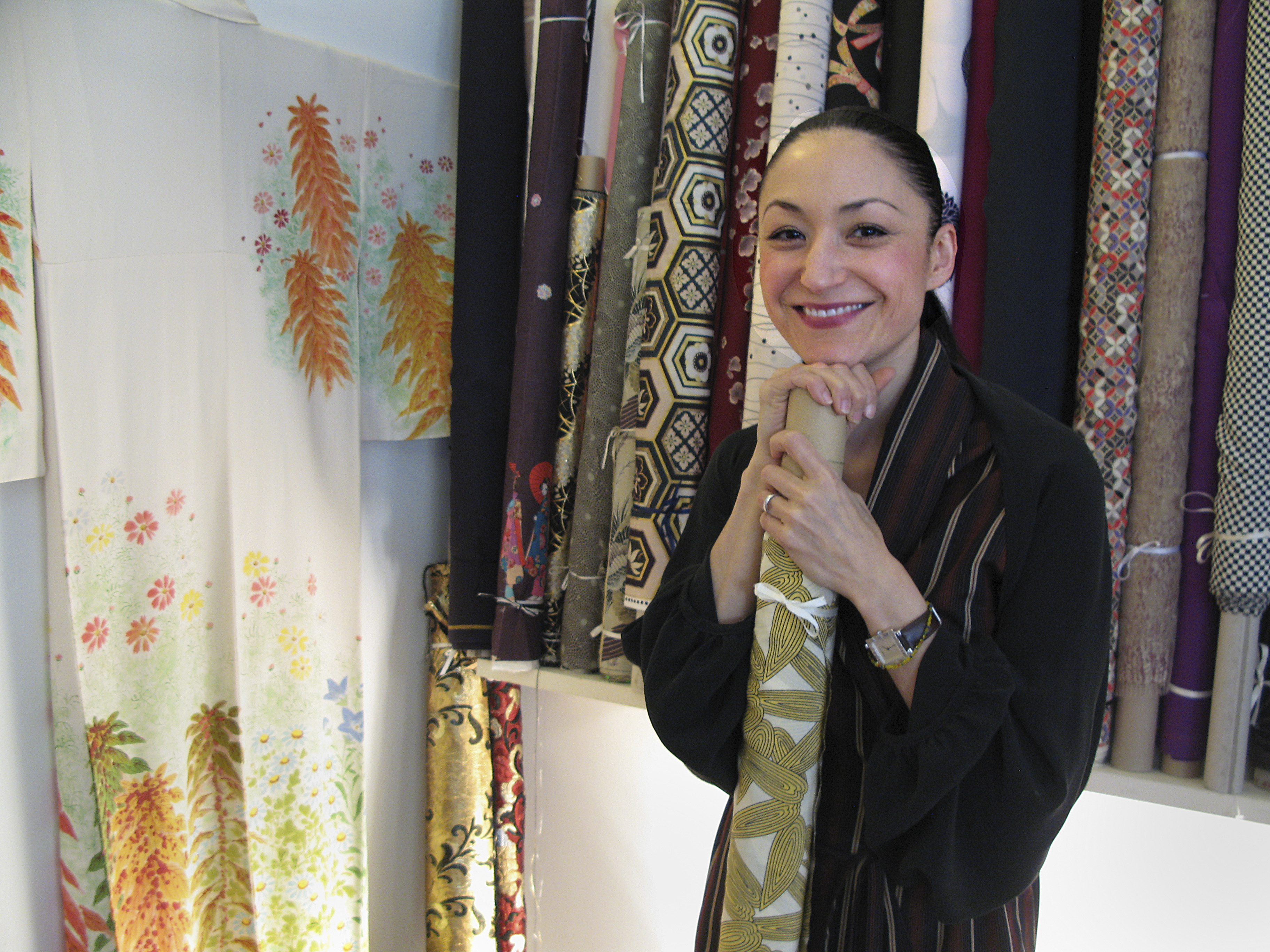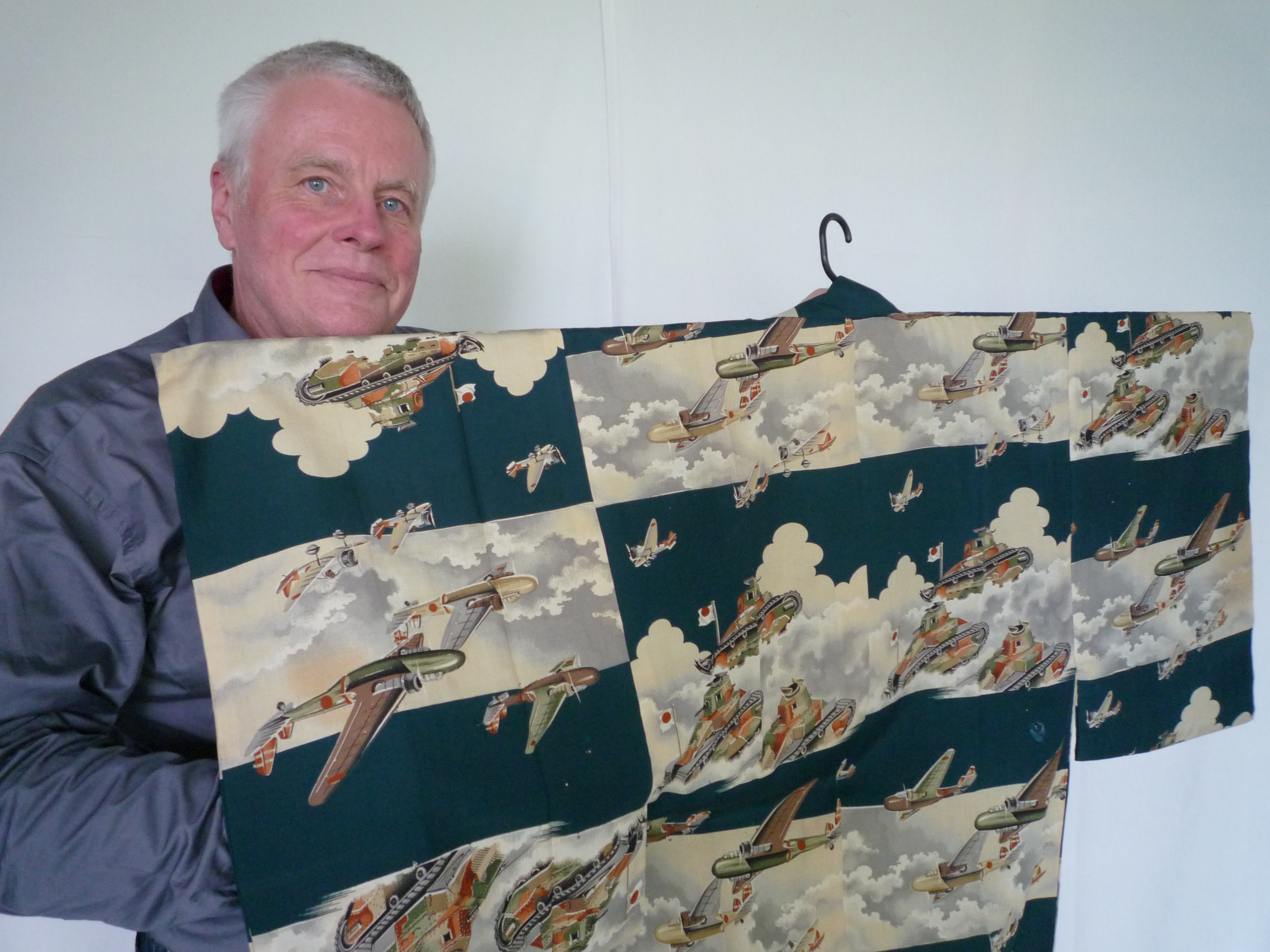Transforming the philosophy of kimono-wearing

Asian-inspired fashions are now an international trend, but a Zurich designer has been combining Japanese aesthetics and European elegance for years.
Kazu Huggler’s corner shop and atelier in Zurich’s Hottingen neighbourhood is colourful yet serene, with parquet floors, high ceilings and delicate chandeliers. A cutting table and numerous bolts of fabric dominate one corner, and a white kimono with a floral design is pinned to the wall.
Production is carried out by a handful of dressmakers – all based nearby. When swissinfo.ch visits, two are on hand preparing customer orders.
Huggler doesn’t try to be trendy. Having studied Japanese art and aesthetics, the Japanese-Swiss designer is more interested in creating clothing that is both beautiful and practical.
“For me it’s about how to transform the philosophy of wearing a kimono,” Huggler tells swissinfo.ch. A fan of traditional kimonos, she dismisses the notion that these are uncomfortable.
“They’re actually very comfortable if you know your body well and know how much space you need to walk, breathe and eat. It just takes a lot of practice. I’m at my most focused when wearing a kimono,” she says, pointing out that you can’t rush around or eat on the run in one.
But as much as she likes kimonos, Huggler feels self-conscious wearing them on Swiss streets. So for her label KAZU, she often recycles the fabric of old ones to create new dresses, skirts and other garments. These may have stains or other signs of wear and tear – and have to be laundered carefully. She also has to be careful about marketing clothing made from these.
“Unless it’s a family heirloom, Japanese women don’t like to wear other people’s old kimonos. And even if people here don’t mind that they’re second-hand, I always want to know where they came from and whether they were worn by someone who was ill or something,” Huggler says.
Some clients bring in their own kimonos bought as souvenirs and ask Huggler to cut them into more wearable designs.
“This is a nice personal approach,” Huggler finds.
Born in Tokyo to a Japanese mother and a Swiss father in 1970, Kazu Huggler grew up in both countries. She studied at Keio University in Tokyo as well as the Swiss University of Art and Design and London’s Central Saint Martins College of Art and Design. In addition to working for Swiss silk giant Fabric Frontline Zurich, she apprenticed for designer Vivienne Westwood in London. She launched her own label, KAZU, in 2002.
After an earthquake and tsunami devastated Japan in March 2011, Huggler launched two projects in the Rikuzen Takata region – which was particularly hard hit. In addition to donating Bernina brand sewing machines to the local high schools, she’s been helping older women create and market products such as tote bags.
Current trends
As she established KAZU in 2002, Huggler’s work predates the current runway trends by more than a decade. For example, the spring collections of global labels like Etro, Prada and Emilio Pucci include silky prints with typically Asian-style motifs – in particular, blossoms.
Meanwhile, kimono and Samurai elements feature in the latest designs of Belgian Haider Ackermann and Brit Gareth Pugh (Ackermann was the winner of the 2004 Swiss Textiles Award; Pugh was nominated for the award in 2007).
Because she doesn’t cater to the masses, Huggler of KAZU doesn’t need to worry about whether garments with a Japanese flair will remain popular. In fact, popularity doesn’t interest her much, anyway. While studying fashion at Saint Martins in London, she remembers being told that anything too new or outlandish wouldn’t sell.
“But it’s not good to be afraid while creating something,” Huggler believes.
She also notes that in contrast to Japan, Switzerland isn’t a “fashion country”.
“In Japan, teens are more dominant – there’s a more playful youth culture. They may be reserved in their speech, but their clothes are wild,” Huggler says. Personally, the bi-national designer likes European elegance in combination with the purity of Japanese aesthetics.

More
Kimonos reveal Japanese wartime history
Simple shapes
For a boutique specialising in made-to-measure attire, KAZU has quite a variety of garments on display: dresses, tunics, skirts and scarves. Many of them showcase prints that Huggler designed. She draws her inspiration from ancient patterns, family crests and nature motifs like hemp, bamboo, cranes and other animals. Some of her current work features velvet appliques derived from symbols used by Japan’s indigenous Ainu people to ward off evil spirits.
In contrast to the prints, the cuts are relatively plain.
“It’s important for the garments to have simple shapes and silhouettes so that the textiles can come alive,” Huggler says, noting the dominance of patterns and colours in much of her work. For each collection she creates two or three prints, which she then develops with Mitloedi, a Swiss screen printer, and Seiren, a Japanese inkjet company. As for material, Huggler is partial to silk.
“For me, silk is the essence of couture – whether it’s a kimono or an evening gown,” Huggler says. She also works with cotton and a high-quality polyester.
In addition to travelling on business regularly, the mother of two small boys always tests her garments for wearability. For as beautiful as her floor-length creations are, she knows that women also need clothing that works on an everyday basis.

In compliance with the JTI standards
More: SWI swissinfo.ch certified by the Journalism Trust Initiative









You can find an overview of ongoing debates with our journalists here . Please join us!
If you want to start a conversation about a topic raised in this article or want to report factual errors, email us at english@swissinfo.ch.